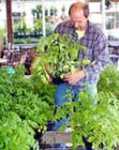Warm weather putting kinks in many gardening schedules

SIKESTON -- Spring's unseasonably warm weather has put a few kinks in the University of Missouri Extension's vegetable planting calendar, therefore allowing gardeners to begin their growing ahead of schedule.
According to the gardening guide, the average date to begin planting sweet corn is April 15 in Southeast Missouri. For green beans, it's April 5.
But longtime gardener Hoyt Kyle of Sikeston said due to the warmer weather this year, he and his brother, who together own about a two-acre garden in Morley, have already planted their first round of sweet corn. Later this week, they'll plant green beans, and in another couple weeks, another round of sweet corn, Kyle said.
Each year the brothers plant sweet corn, beans, sweet potatoes and okra as a hobby and later freeze the corn and okra, can the beans and store the sweet potatoes, Kyle said. "If the weather stays like this, it is OK to bump things up by a week," approved Anthony Ohmes, agronomy specialist for the Mississippi County University Outreach and Extension.
Those who do decide to plant a little early should have a backup means of protecting their plants, such as a sheet, in case a frost is forecast, pointed out Tim Baker, university extension horticulturist specialist for the Southeast region.
The general rule is to plant some of the cold crops like carrots and lettuce in March, then mid-season crops like the corn and beans in April and vining crops like squash and zucchini around May 1.
And for those not as experienced in gardening, Ohmes and Baker have a few suggestions.
"If they've not had a garden in a while and have not done anything to the soil, it's a good idea to start out with a soil test," Baker advised. "That will give an idea of what nutrients are there."
Also, tilling a garden every single year is not always the best idea, Baker noted. While area on the topsoil is nice and loose from tilling, as the tines of the tiller beat down, it compacts the soil at that level, he explained. So the ideal way to do it is to break the soil up with a deep plow, he said.
"If the ground is lawn, there will be a lot of roots and you should try to remove them as best as possible, especially if you have Bermuda grass," Baker said.
A sunny spot is generally the best location for a garden, Baker said. For those who don't have the choice for a sunny spot, raised garden beds work well for low areas that may collect water and promote diseases, he said.
And according to Kyle, a good watering and fertilizing system are key to having a successful garden.
"We usually try to put an inch of water per week -- either by rain or irrigation," Kyle said. "Of course we have to treat the sweet corn for the worms so we put mineral oil on silk to keep the worms away."
As far as what to plant, most of the cool season crops like carrots, lettuces, broccoli, and cabbage should have been planted by now, but warm weather crops like tomatoes, peppers, eggplants, watermelons and cantaloupes can still be planted, Baker said.
Some people will buy transplants, which is easier for the first years of gardening, Baker said. Theoretically, it's better to start with a seed and transplant it, he explained.
And when it's time to finally plant the seed, Baker said just remember: "Think if you were a seed, where would you want to be planted."
Always check the plant's package to see what it requires as far as the number of temperature hours it requires to reach maturity, Ohmes warned. Make sure plants are properly spaced, he said, adding the MU guide can tell how deep to plant and how wide rows should be.
"Plants can compete with each other. If they get too close together, they won't yield the amount they should," Ohmes said.
To receive a copy of the MU Guide's Vegetable Planting Calendar, contact your local University of Missouri Outreach and Extension office and request guide number G6201.

